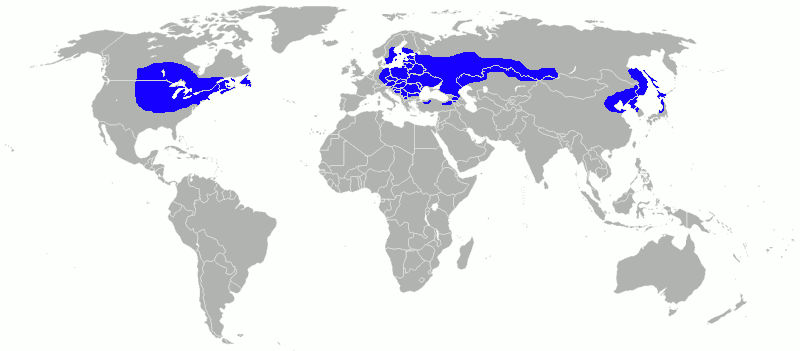The first time I remember seeing a tulip tree (Liriodendron tulipifera) was during a family trip to Virginia. I didn't think that it grew as far north as Massachusetts. I was quite wrong. It's far from common, but it is occasionally planted as a landscape tree, and can survive. When I started at my current job a couple of years ago, I realized when spring came that there was a big specimen growing right next to the parking lot.
 It's impossible to fit the whole tree into one picture from the parking lot.
It's impossible to fit the whole tree into one picture from the parking lot.The tulip tree, aka yellow poplar, is a native of much of the United States east of the Mississippi, more common in the southeast but obviously capable of growing as far north as Massachusetts - though we are on the extreme northern edge of its range. It's a very distinctive and remarkable tree. In sheer size, it can be one of the largest trees in eastern North America, growing to more than 160 feet/50 meters tall in the more southern parts of its range. The leaves, flowers, and seeds are very distinctive and not easy to mistake for anything else once you get a close look at them.
The most distinctive feature of all, and the one that gives the tree its name, are the flowers. They are large and showy, a mixture of yellow, orange, and green, and shaped somewhat like tulips - hence the name for the tree. Unfortunately, the flowers tend to be mostly on the middle and upper branches of the tree, so it can be difficult to get a good closeup, especially on a fairly large tree.
 Tulip tree flowers - pale yellow and orange in color
Tulip tree flowers - pale yellow and orange in color
The most distinctive feature of all, and the one that gives the tree its name, are the flowers. They are large and showy, a mixture of yellow, orange, and green, and shaped somewhat like tulips - hence the name for the tree. Unfortunately, the flowers tend to be mostly on the middle and upper branches of the tree, so it can be difficult to get a good closeup, especially on a fairly large tree.
 Tulip tree flowers - pale yellow and orange in color
Tulip tree flowers - pale yellow and orange in colorThe name for the tree may come not only from the shape of the flowers themselves, but also from the shape of the leaves. They have a similar shape to the outline of some types of tulip flowers when seen from the side. They also look a little like maple leaves, but they have 4 lobes rather than the 5 or 3 lobes that maple leaves have. Tulip tree leaves lack a middle lobe of the type that gives maple leaves a "tip" in the center.
 Closer view of Tulip tree leaves - 4 lobes total, no central lobe
Closer view of Tulip tree leaves - 4 lobes total, no central lobe
 Closer view of Tulip tree leaves - 4 lobes total, no central lobe
Closer view of Tulip tree leaves - 4 lobes total, no central lobeTulip trees are related to magnolias, but they have no really close relatives (in the same genus) in North America. Their closest relative is in fact a native of China - Liriodendron chinense. It may seem bizarre that the closest relative of a plant native to the eastern USA is found in China, on the opposite side of the northern hemisphere, but in fact many plants from both eastern and western North America have close relatives in China and other parts of eastern Asia. For tens of millions of years, the two continents have apparently been exchanging plant and animal species through several different means - dry land bridges or bridges of closely-spaced islands caused by either lower sea levels or geological activity, or by migrating birds and wind-blown seeds. In the distant past, tens of millions of years ago, it was also apparently easier for Asia and North America to exchange plant species because the world's climate was both warmer and wetter, so even the high arctic latitudes where the two continents came closest too each other were covered with temperate or even subtropical forests, rich in plant species that could migrate in both directions. In more recent times, the two continents have been temporarily joined by a land bridge during ice ages, but that land bridge was frigid tundra, which allowed animals - including humans - to move between the continents, but was only useful to plants that were adapted to the coldest tundra conditions - which eliminates most trees!








































